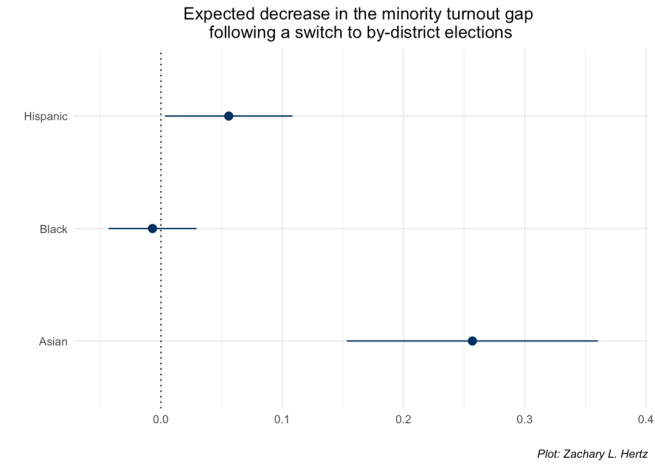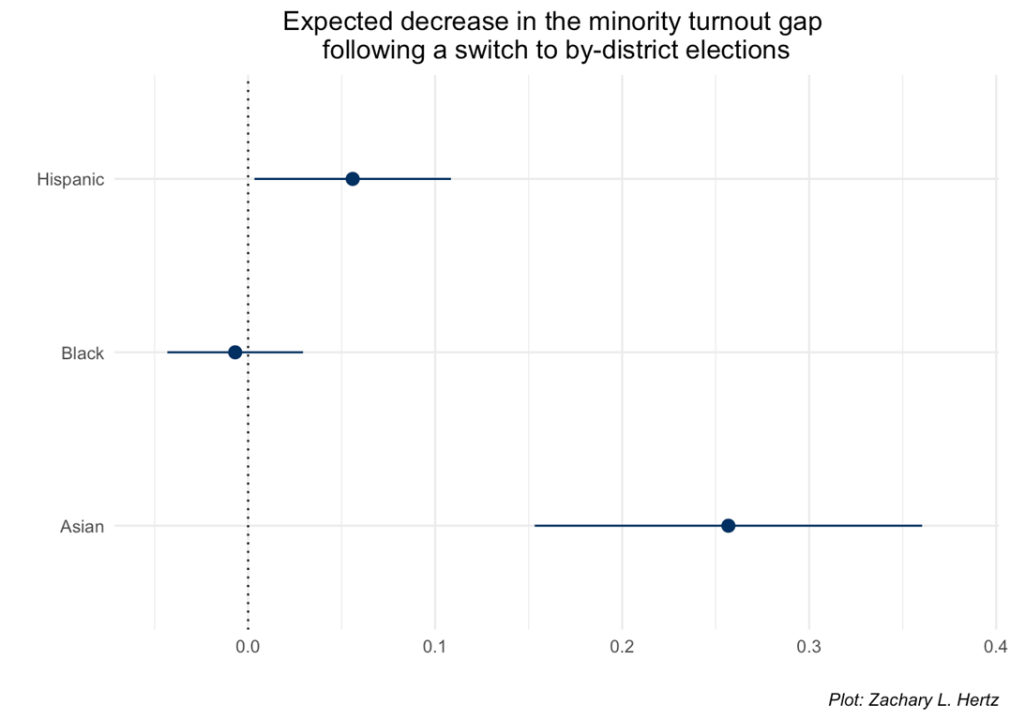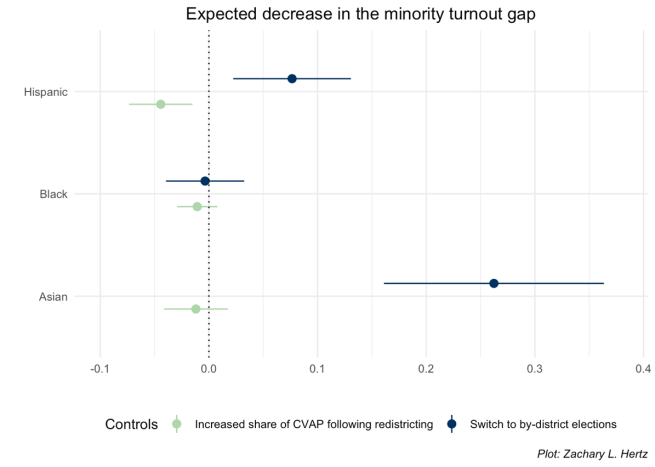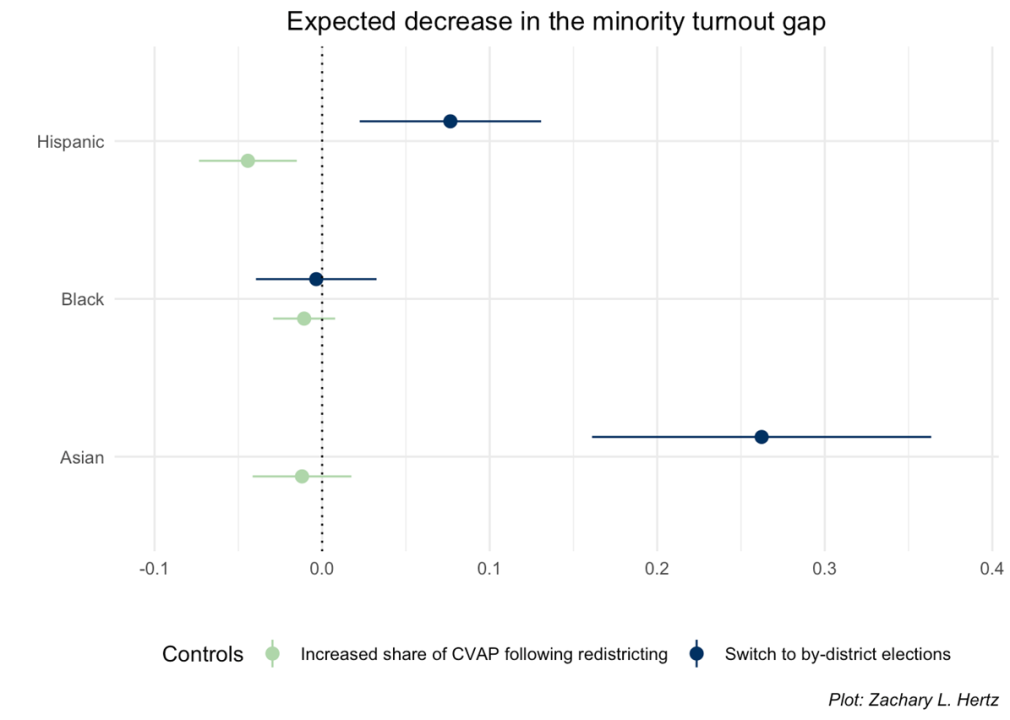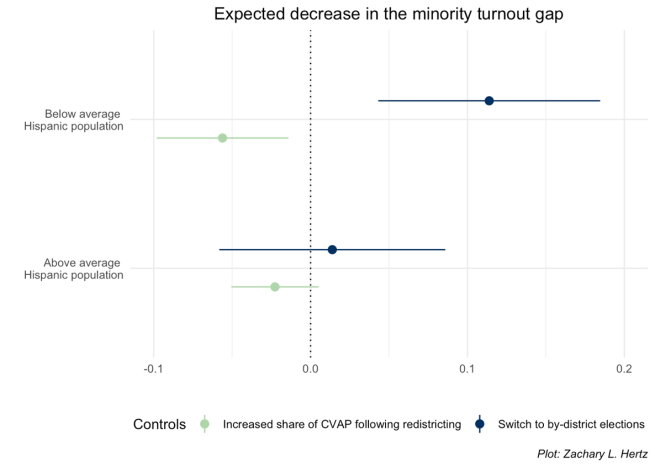Has a Switch to By-District City Council Elections in California Reduced the Minority Turnout Gap?
The MIT Election Data and Science Lab helps highlight new research and interesting ideas in election science, and is a proud co-sponsor of the Election Sciences, Reform, & Administration Conference (ESRA).
Our post today was written by Zach Hertz, based on his paper presented at the 2021 ESRA Conference. The information and opinions expressed in this column represent his own research, and do not necessarily represent the opinions of the MIT Election Lab or MIT.
The California Voting Rights Act (CVRA) targets minority vote dilution in local electoral systems that “impair the ability of a protected class to elect candidates of its choice or its ability to influence the outcome of an election [emphasis added].” In practice, vote dilution claims in city council elections center on at-large voting.
What is the difference between at-large and by-district elections?
In at-large elections for a given city, every seat is decided by a vote among all of the voters in the city. If voting preferences are split along racial lines, a cohesive racial majority will win all the available seats, effectively disenfranchising the minority.
Instead, reformers turn to by-district elections, which divide the city into single-seat districts. When minority racial groups are generally concentrated within particular neighborhoods, it is possible to draw districts that grant racial minorities voting majorities within districts, consequently making it possible for minority groups to win city council seats.
The California Voting Rights Act
By design, the CVRA encourages a switch to by-district elections in two ways. First: the CVRA lowers costs and the threshold for success to plaintiffs, who merely need to provide evidence of racially-polarized voting. Under the CVRA, city governments are responsible for plaintiff’s legal fees in both city losses and settlements. Thus, city governments are encouraged to preemptively adopt by-district elections to avoid costly legal battles and maintain a degree of control over the redistricting process.
More than 80 California cities have begun or completed a switch to by-district elections under the CVRA since its passage, mostly in the last three years. These reforms have faced some resistance; the defense attorney for the city of Modesto argued that the CVRA fails to establish that minority groups actually benefit from adopted by-district elections, and others suggest that the reform has led to fewer minority elected officials than expected. These criticisms, and the magnitude of this institutional reform, raise the question: has a switch to by-district elections under the CVRA increased minority influence on election outcomes?
Measuring electoral empowerment: coethnic candidates or the turnout gap?
To answer this question, researchers must first measure racial minorities’ electoral influence. Coethnic candidates, or candidates belonging to that racial group, are one measure but subject to several important limitations when evaluating the potential benefits of a CVRA-induced switch to by-district elections.
Previous studies have found that some analysis fails to account for the jurisdiction’s racial composition and that by-district elections lead to an increase in coethnic candidates only when a minority group is both highly concentrated and a relatively large share of the population.
Additionally, a study by Collingwood and Long found that adopting by-district elections under the CVRA increased minority representation by 10 percent, and 20 percent in cities with large Latino populations. This has particular implications for city council elections; because city councils have a national average of just six seats which are winner-take-all, a 10 percent treatment effect may be less than a seat and unmeasurable at the candidate level in many cases. Minority groups remain underrepresented among candidates for office, so racially-polarized voting could occur in districts with no coethnic candidates.
Instead, I use the difference between white and minority turnout, or the turnout gap, to measure the CVRA’s effects on minority empowerment in city council elections. The turnout gap accounts for trends across racial groups, reducing the influence of non-racial factors and minimizing the impacts of potential data issues. Why use turnout? Research finds that local officials respond to high-turnout groups and when minority groups are a larger share of the potential electorate, they turn out to vote at higher rates. Thus, if the CVRA creates a district where a minority group is a larger share of the electorate in by-district elections than under at-large elections, we expect a decrease in the turnout gap.
Hypotheses and Research Design
Has a switch to by-district city council elections in California reduced the minority turnout gap? I test three main hypotheses:
- First, I expect that the turnout gap between minority groups and non-Hispanic whites will be smaller in California cities that switched from at-large to by-district elections than in demographically similar cities.
- Second, if a minority group’s share of the electorate increases under the switch to by-district elections, their voting rates will increase and the turnout gap will decrease, compared to jurisdictions where minority groups’ share of the electorate did not increase.
- Finally, I expect to see decreases in the turnout gap occur in cities where a minority group composes a larger than average share of the population.
Data Collection
To test my hypotheses, I utilized difference-in-difference (DiD) estimation, a method often used to evaluate the effects of a given policy. DiD mimics the control and treatment group structure of experimental designs by comparing outcomes over time between a population that enacts the policy and a population that does not implement the policy, allowing researchers to draw causal inferences as to the policy’s effect.
I first identified a treatment group of California cities that had fully completed a switch to by-district elections following threatened or actual CVRA lawsuits; in other words, the 30 cities where each new city council seat is held by a member elected through a by-district election.
For a control group, I use cities defined in previous work by Collingwood and Long. They join city-level race, education, income, age and population change demographics with party registration data to perform nearest-neighbor matches and produce a control group of cities with at-large city council elections that are demographically comparable to individual cities in the treatment group.
My analysis requires racial turnout data at both the city and district level, which proved a more difficult task. Turnout is defined as the total number of votes divided by the citizen voting-age population (CVAP) in an electoral unit. I turned to the California Elections Data Archive (CEDA) to find the numerator, or total votes in a given city/district. I pulled city-level CVAP data from the American Community Survey (ACS) for the denominator, but district-level CVAP estimates proved more elusive. Fortunately, the National Demographics Corporation, an organization that worked directly with 23 of the 30 cities to leverage ACS data into district-level demographic data, provided me with district-level CVAP estimates and other demographic data. While this restricted my work to these 23 pairs of cities, it provides greater confidence in the demographic data at the center of my study.
Finally, I needed to calculate turnout data by race. I used ecological inference to construct turnout by racial group at both the city and district level from the vote totals, CVAP and demographic data. I then calculated the turnout gap, per Fraga, as the difference between turnout rates of a given minority group and non-Hispanic Whites. Thus, the turnout gap is 0 if a minority group and non-Hispanic Whites vote at equal rates, positive if the minority group turns out at a higher rate than non-Hispanic Whites in the jurisdiction, and negative if the minority group turns out at lower rates than non-Hispanic Whites. Because the turnout gap is generally negative, a positive increase in the measured value of the turnout gap will generally lower the distance between minority and White turnout rates.
Research Design
Finally, I created a dataset with a pre-treatment and post-treatment observation for each treated city and its pair. To use DiD to estimate the average treatment effect of a shift from at-large to by-district elections on the turnout gap, I constructed a linear regression model following that outlined by Bertrand, Duflo and Mullainathan, clustering standard errors by city and controlling for election year and city effects.
In this model, equation I in Figure II, Y is the quantity of interest: the turnout gap between a given minority group and non-Hispanic whites given as a percentage difference. As represents the fixed effects for a city, Bt represents fixed effects for election years, Xist are relevant individual controls and εist is an error term. Ist is a dummy variable indicating whether a city has undergone redistricting at time t. I use this equation to create three fixed effect linear regression models and test my first hypothesis.
I used a similar model to test my second hypothesis, but included a dummy binary variable, G, to indicate whether a minority group increased in relative population share as a result of the switch to by-district elections. G = 1 if an observation in the panel dataset is in the treatment group, post-treatment, and the minority group in question is a larger share of the newly-created district than the city at large. In all other cases, G = 0.
Because Hispanics are the only minority group that compose a meaningfully large mean share of the local electorate in California, I limit the test of my third hypothesis to Hispanics. I created a subset of treated cities with a Hispanic CVAP population greater than the mean value of 38.2 percent, including their appropriate paired control, considered “High Hispanic population”. I then repeated my analysis from above.
Results
Figure III presents the results from the regression models testing my first hypothesis. I find that adopting districts under the CVRA decreased the turnout gap by 5.6 percentage points for Hispanic Americans and nearly 26 percentage points for Asian Americans. A switch to by-district elections did not have a statistically significant effect on the turnout gap for Black Americans. Because I expect these effects to be largest when minority groups are a considerable share of the population and Black Americans compose only 5.6 percent of the voting population on average in the sample, the null effects are unsurprising.
Figure IV presents the results from regression models including controls for both the switch to by-district elections and an increase in a minority group’s share of the electorate. For Asian Americans and Black Americans, an increase in the voting population does not seem to reduce the turnout gap. Among Hispanic Americans, this model suggests that a switch to by-district elections leads to a slightly larger 7.7 percentage point decrease in the turnout gap. But the model also finds an expected increase in the turnout gap of 4.4 percentage points when drawn districts increase Hispanics’ share of the voting population.
Finally, Figure V presents the results from tests of two subsets: cities with higher-than-average and lower-than-average Hispanic populations. Counter to my hypothesis, there are no statistically significant effects among cities that are more Hispanic than average. However, among cities with lower-than-average Hispanic populations, I find a switch to by-district elections decreases the turnout gap by 11.4 percentage points. I also find that districts that increase Hispanics’ share of the electorate lead to a 5.6 percent increase in the turnout gap.
Significance
I find initial evidence suggesting that a switch to by-district elections under the CVRA reduces the turnout gap. Contrary to my hypothesis, however, I do not find evidence that an increase in relative group size leads to a decrease in the turnout gap. Additionally, while I hypothesized that these effects are stronger in cities where a minority group is a higher than average share of the total population, I find effects of a switch to by-district election are actually stronger in cities where minorities are a lower than average share of the population.
What might explain these surprising findings? As noted by Trounstine and Valdini, geographic concentration moderates the effects of by-district elections on turnout, but my data cannot measure geographic dispersion. Perhaps cities with smaller Hispanic populations more easily create districts with geographically compact Hispanic populations.
As more cities complete a switch to by-district elections under the CVRA, future researchers should incorporate measures of geographic dispersion and benefit from an expanded treatment universe to produce more robust findings. In doing so, scholars will continue to clarify the CVRA’s role in improving racial representation and inform states considering similar policies.




